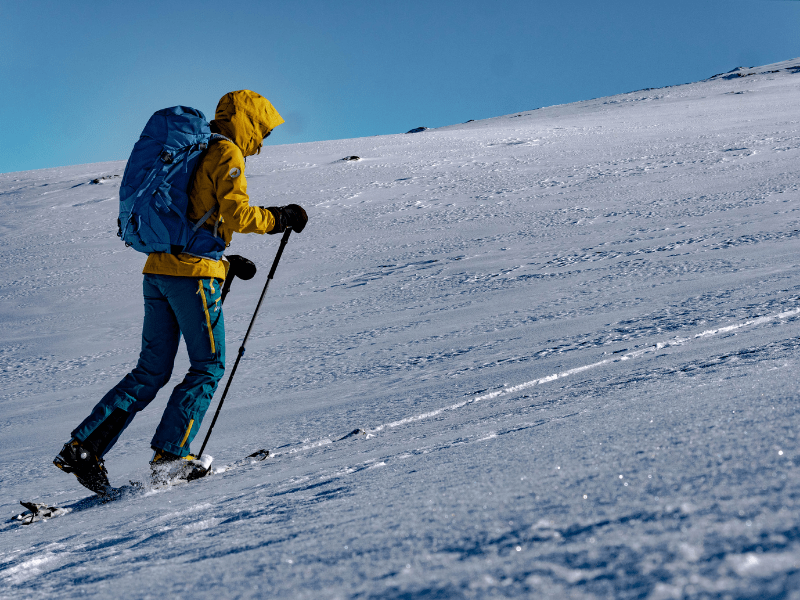How bad for the environment is a ski holiday? How sustainable is the ski industry? Massive engines on gondolas, chair lifts, snow cannons, piste-bashers, shuttle buses, cars, taxis, heating hotels, swimming pools… the short answer is: not very! To be perfectly honest – the most environmentally-friendly thing to do is not go skiing at all…
But, then, no-one would be happy! Therefore, we wanted to take a look at some changes we can all support – from quick swaps and waste-savers, to significant technology overhauls. Doing so will mean that mountains and ski resorts stay in the ski-able conditions we like, for many more years to come.
We want to preface this post by acknowledging we – The Chalet Company and the wider ski industry – have a long way to go! Step one is recognising the problem and we’re now at step two: pursuing action and making changes.
 Could you drive to a ski resort?
Could you drive to a ski resort?
 Hotels are starting to use plastic-free toiletries
Hotels are starting to use plastic-free toiletries
 Try touring as an alternative way up the mountain
Try touring as an alternative way up the mountain
 Say no thanks to plastic at the supermarket, and make your own lunch
Say no thanks to plastic at the supermarket, and make your own lunch
Seems impossible, why bother?
We’re interested in this subject because, if we continue contributing to climate change in the same way, it will affect ski resorts irreparably. Warmer temperatures will lead to shorter seasons and less available (but more expensive) ski holiday weeks. Disturbed weather systems will also lead to unstable snowpack e.g. more runs closed, more avalanche risks and even higher winds whisking your precious snow straight off the slopes. The great thing is, many brands, suppliers, politicians and governing bodies are getting on-board with protecting ski resorts through more sustainable practices. We all have a part to play so, without further ado, *gets off soapbox* here’s what to consider:Travelling to a ski resort
You can make small changes before you’ve even left the house. Turn off or lower any heating and turn off appliances at the wall/socket. Avoid leaving lights on for security – invest in a system with a timer, or ask a friend to pop round occasionally. In terms of transport, finding an alternative to carbon-heavy air travel is key. We love driving to a ski resort and bonus points if you have a hybrid or electric car. Type ‘Electric Vehicle Charging’ into Google Maps, to see all the charging points (and their availability) along your route. You could also look into taking the train. Getting the train to a ski resort has just as many benefits as driving: no luggage allowance, less carbon consumption etc. An added benefit is that you’re not behind the wheel and can stretch your legs at any time.* If you do end up flying, pack as light as possible – every bit of weight onboard requires extra fuel for a plane. Consider carbon offsetting your flight too. Try to take public transport to the airport, and a shared transfer onwards to the ski resort. Could you drive to a ski resort?
Could you drive to a ski resort?
Ski gear and shopping
It goes without saying that skiing and snowboarding requires specialist kit. However, the garment industry is responsible for a huge slice of carbon emissions (10%!). Additionally, waterproofing or insulating ski and snowboard clothes can be an intensive process. For this reason, try to invest in quality gear that is built to last. Buy from brands who have a sustainability focus, whether that’s through using recycled materials, using local suppliers, or an associated repair service (either way, learn to make simple repairs yourself). Do a bit of digging to check that their claims are legitimate and not just ‘green-washing’ e.g., rustic brown paper packaging and vague statements on their website. When you’re in resort, you might be inspired to shop or update your kit, but think carefully if you actually need new things. Additionally, take the same approach to souvenirs – put down the ‘novelty’ plastic tat! If you do want to bring a gift home for someone, look for a local product with minimal packaging. Hotels are starting to use plastic-free toiletries
Hotels are starting to use plastic-free toiletries
In your accommodation
Consider your accommodation carefully. Hotels and chalets are often a minefield of single-use items: think mini toiletries, condiments at breakfast etc, so look out for certifications like LEED and Green Globe. On the other hand, self-catering often leads to a lot of waste – if you have to buy everything from scratch for an empty apartment. Our top tip for self-catering sustainably, is to decant small amounts of washing up liquid, toiletries, salt & pepper etc. and bring them from home. Laundry is a huge consumer of energy in the hospitality sector. Opt not to have a towel change mid-way through your week; make it clear if you haven’t used towels; or hand in ones you know you won’t need. Another energy sink-hole in ski resorts is obviously heating. Try to be as economical as possible with the heating in your room/apartment/chalet. You’ve got thermals with you after all! Request an extra blanket, and bring slippers/dressing gowns with you to keep you cosy when you’re chilling. Make sure lights, heating and appliances are turned off all day when you’re on the mountain. Lastly, it can be a confusing system when it’s not the same as home, but do make an effort to recycle even the smallest bits of waste. Only put things that genuinely can’t be recycled into the ‘rubbish’. Try touring as an alternative way up the mountain
Try touring as an alternative way up the mountain
Sustainability on the snow
You can lessen your impact in couple of small ways out on the mountain. Firstly, download the piste map on your phone, so that you don’t need a paper one. Secondly, remember to recycle your lift pass at the end of your stay. There are usually drop-off spots near lift offices. Consider taking a day off the lifts and go touring and/or snow-shoeing. You’ll appreciate the mountain in a whole new way, arguably earn those turns even more, boost your fitness, and save a day’s worth of lift-fuel. However you choose to travel up the mountain, always take a pair of shoes in your backpack – it means you can change into them and probably walk back to your accommodation, rather than squashing onto a bus. Human litter has had a bit impact on our mountain environments. This is everything from cigarette butts, to food waste, to ski/board wax. Get a little tin to stick cigarette ends in, to empty at a later time. Don’t drop litter, even things you consider ‘biodegradable’ like fruit peel; it can take anywhere between six months and two years to start biodegrading in the mountains. Go one step further – if you see a bit of litter in the snow, pick it up, pop it in your pocket and bin later. Good karma, and good for the planet. Lastly, consider the wax you use on your board or skis. This might not apply if you don’t have your own kit (or if you don’t service your own kit). Most ski wax is petroleum-based and finds its way into mountain water-systems and eco-systems as snow melts. Look for a nature-friendly wax like Mountain Flow’s. Say no thanks to plastic at the supermarket, and make your own lunch
Say no thanks to plastic at the supermarket, and make your own lunch


